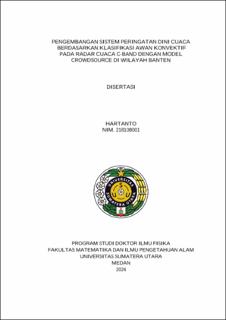| dc.description.abstract | Banten is one of the regions in Indonesia that often faces the threat of extreme weather impacts. Convective clouds that form can be related to the development of intense storms that produce extreme weather, such as heavy rain, hail, lightning, and strong winds. The ability to forecast weather and issue early warnings of extreme weather and heavy rain is critical. To minimize the impact of extreme weather, Meteorology, Climatology and Geophysics Agency (BMKG) has installed weather instrument spread across various regions, such as the Automatic Rain Gauge (ARG). The low distribution of instrument will affect the accuracy of weather information, so remote sensing instruments such as weather radar can be used as an alternative in supporting the generation of weather information. Weather radar can monitor convective cloud activity in the atmosphere and detect rainfall patterns and cloud intensity in high spatial and temporal areas. On the other hand, weather radar has limitations such as beam blockage and attenuation effects, affecting the accuracy of weather radar observations. Improving the accuracy of weather radar is necessary so that it is developed into weather early warning information integrated with the crowdsourcing method, where the public provides reports on weather conditions in their neighborhood to improve the performance of the early warning system. The development of a weather early warning system with a crowdsource model has been carried out; the results of the development obtained by weather radar can detect convective cloud types with reflectivity values of 36 -51.5 dBZ for heavy rain and very heavy rain in the range of 47.5 - 58.0 dBZ. These results are supported by an evaluation of accuracy of rainfall estimates produced by weather radar to ARG rainfall data in Banten, namely the correlation value above 0.7 and the influence of the Z-R constant, distance, location, and topography contribute to the quality of the estimator. From this research, InaWAS application was also obtained, which integrates weather radar observation data with the crowdsource method in supporting the accuracy of weather information services and weather early warnings so that people not only get weather information but also participate in reporting weather conditions in their respective locations. | en_US |


